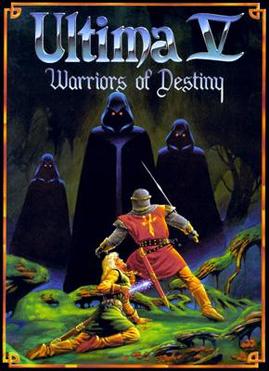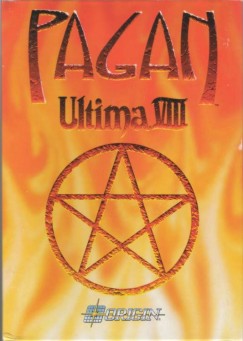
System Shock is a 1994 first-person action-adventure video game developed by LookingGlass Technologies and published by Origin Systems. It was directed by Doug Church with Warren Spector serving as producer. The game is set aboard a space station in a cyberpunk vision of the year 2072. Assuming the role of a nameless security hacker, the player attempts to hinder the plans of a malevolent artificial intelligence called SHODAN.

Ultima is a series of open world fantasy role-playing video games from Origin Systems, created by Richard Garriott. Electronic Arts has owned the brand since 1992. The series had sold over 2 million copies by 1997.

Looking Glass Studios, Inc. was an American video game developer based in Cambridge, Massachusetts. The company was founded by Paul Neurath with Ned Lerner as Blue Sky Productions in 1990, and merged with Lerner's Lerner Research in 1992 to become LookingGlass Technologies. Between 1997 and 1999, the company was part of Intermetrics and was renamed Looking Glass Studios. Following financial issues at Looking Glass, the studio shut down in May 2000.

Warren Evan Spector is an American role-playing and video game designer, director, writer, producer and production designer. He is known for creating immersive sim games, which give players a wide variety of choices in how to progress. Consequences of those choices are then shown in the simulated game world in subsequent levels or missions. He is best known for the critically acclaimed video game Deus Ex that embodies the choice and consequence philosophy while combining elements of the first-person shooter, role-playing, and adventure game genres. In addition to Deus Ex, Spector is known for his work while employed by Looking Glass Studios, where he was involved in the creation of several acclaimed titles including Ultima Underworld, Ultima Underworld II, System Shock, and Thief: The Dark Project. He is employed by OtherSide Entertainment, where he was part of the development team for the stalled System Shock 3. He is currently working on a new immersive sim based on an original intellectual property.

Ultima V: Warriors of Destiny is the fifth entry in the role-playing video game series Ultima released in March 1988. It is the second in the "Age of Enlightenment" trilogy. The game's story takes a darker turn from its predecessor Ultima IV. Britannia's king Lord British is missing, replaced by a tyrant named Lord Blackthorn. The player must navigate a totalitarian world bent on enforcing its virtues through draconian means.

Ultima VI: The False Prophet, released by Origin Systems in 1990, is the sixth part in the role-playing video game series of Ultima. It is the third and final game in the "Age of Enlightenment" trilogy. Ultima VI sees the player return to Britannia, at war with a race of gargoyles from another land, struggling to stop a prophecy from ending their race. The player must help defend Britannia against these gargoyles, and ultimately discover the secrets about both lands and its peoples.

Ultima VII: The Black Gate is the seventh installment of the Ultima series of role-playing video games, released in April 1992. In it, the player returns as The Avatar, a would-be paragon of moral virtue who faces down many dangers and deceptions in order to cleanse the medieval fantasy world of Britannia of assorted plots and schemes, monster infestations, and the undermining of crown authority.

Ultima VIII: Pagan is a role-playing video game, released as the eighth part of the Ultima series. Released in 1994, it is a DOS-only title and is also the first game in the series to be rated M in North America. It was not as well-received as its predecessors, Ultima VII and Ultima VII Part Two: Serpent Isle.

Ultima VII Part Two: Serpent Isle is a role-playing video game released in 1993 as part of the core Ultima series, its story beginning eighteen months after the conclusion of Ultima VII: The Black Gate. In Serpent Isle, the Avatar follows Batlin to the eponymous land called Serpent Isle, finding three city-states founded by those who left Britannia generations before and ancient ruins from a still-older lost civilization that was there long before them.

Doug Church, is an American video game designer and producer. He attended MIT in the late 1980s, but left and went to work with Looking Glass Studios, when they were making primarily MS-DOS-based immersive sim games, including Ultima Underworld, Ultima Underworld II, System Shock and Thief. His colleague Warren Spector claims, in fact, that Church was the one who originally coined the term "immersive simulation".

Ultima Underworld: The Stygian Abyss is a first-person role-playing video game developed by Blue Sky Productions and published by Origin Systems. Released in March 1992, the game is set in the fantasy world of the Ultima series. It takes place inside the Great Stygian Abyss: a large cave system that contains the remnants of a failed utopian civilization. The player assumes the role of the Avatar—the Ultima series's protagonist—and attempts to find and rescue a baron's kidnapped daughter.

Terra Nova: Strike Force Centauri is a 1996 tactical first-person shooter video game developed and published by LookingGlass Technologies. Set in a science-fictional depiction of the 24th century, the game follows a faction of humans who colonize the Alpha Centauri star system to escape from the Hegemony, a totalitarian Earth government. The player assumes the role of Nikola ap Io, the leader of an Alpha Centauri military unit, and undertakes missions against pirates and the Hegemony.

John Madden Football '93 is a 1992 sports video game developed by Blue Sky Productions and Electronic Arts and published by EA Sports. Based on the sport of American football, the player controls a football team in modes such as tournament play and sudden death. Officially endorsed by John Madden, it was the third Madden game for home consoles and the first one that saw a simultaneous release on both, the Sega Genesis and Super NES.
An action role-playing game is a subgenre of video games that combines core elements from both the action game and role-playing genre.
The action-role playing game Deus Ex (2000) was developed over 34 months by a team of approximately 20 people at the American company Ion Storm. Team director and producer Warren Spector began to plan the game in 1993 after releasing Ultima Underworld II with Origin Systems and attempted the game both there and at Looking Glass Technologies before going into production with Ion Storm. Official preproduction began around August 1997, lasted for six months, and was followed by 28 months of production. Spector saw their work as expanding on the precedent set by Origin, Looking Glass, and Valve.
OtherSide Entertainment, Inc. is an American video game developer based in Boston, Massachusetts, founded in 2013 by Looking Glass Studios co-founder Paul Neurath. In June 2016, the company opened a second studio in Austin, Texas, led by Warren Spector. OtherSide developed Underworld Ascendant (2018), a spiritual successor to Looking Glass's Ultima Underworld series, and is developing a new intellectual property.

Underworld Ascendant is a first-person action role-playing game developed by Otherside Entertainment and published by 505 Games. It is the sequel to Ultima Underworld: The Stygian Abyss and Ultima Underworld II: Labyrinth of Worlds. Players assume the role of the Avatar, as they return to the Stygian Abyss. As in the original games, there is an emphasis on non-linear progression, simulated systems, and emergent gameplay. It was released on Microsoft Windows on November 15, 2018.
An immersive sim (simulation) is a video game genre that emphasizes player choice. Its core, defining trait is the use of simulated systems that respond to a variety of player actions which, combined with a comparatively broad array of player abilities, allow the game to support varied and creative solutions to problems, as well as emergent gameplay beyond what has been explicitly designed by the developer. This definition is not to be confused with game systems which allow player choice in a confined sense or systems which allow players to easily escape consequences of their choices.















